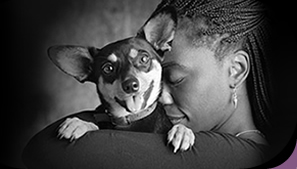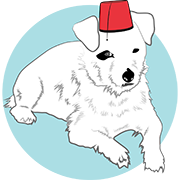 There are a lot of important pieces in the pet adoption puzzle. Getting people to see shelter pets as desirable is a primary one. It’s the impetus behind my Pet Adoption Videos that Don’t Make You Want to Kill Yourself series.
There are a lot of important pieces in the pet adoption puzzle. Getting people to see shelter pets as desirable is a primary one. It’s the impetus behind my Pet Adoption Videos that Don’t Make You Want to Kill Yourself series.
Getting shelter pets to actually be desirable is even more crucial.
Dogs barking, jumping, stepping in their own excrement… When people are trying to envision a pet in their home, that’s not what they want to see, hear, or smell. And — let’s face it — a lot of people don’t want to stay in that shelter environment long enough to try to interact with potential adoptees.
Enter Open Paw, a program that looks at these problems from a trainer’s perspective. It’s been around for nearly a dozen years, and it’s been spreading around the world. In this week’s Animal Cafe podcast, Mary Haight talks with Kelly Dunbar, Open Paw’s President and co-founder and — full disclosure — one of Animal Cafe’s four regular correspondents.
Open Paw’s Premise: Mental Health Counts too
Shelters tend to focus on the physical health of the animals, on preventing infectious diseases like parvovirus. There’s no question that this is important. But there’s nothing more unhealthy than being killed — and that’s what happens too often to animals that have mental health problems, problems created by the shelter environment.
Picture this instead: A friendly, clean and quiet place, one that is very welcoming. It’s a shelter that recognizes that behavioral health and manners are as important as physical health. As Kelly puts it, “Most animals will start to deteriorate within two weeks in a shelter. If you want to adopt animals out, you’ve got to up your game. A shelter environment is never going to be as good as almost any home.”
Creating a shelter that hastens adoptions is not expensive, Kelly says. “It can be done on a shoestring. All you need is education and time.” In order to maintain animals’ mental health, only a few basics are required: A separate toilet area; exposure to a lot of new people and sounds; and games — as simple as a stuffed Kong — to keep the mind occupied.
Creating a potty area that is not in the kennels and providing access to it several times a day is perhaps the most important element, benefiting both the dogs and the volunteers. Dogs learn not to soil their homes, and volunteers have more time to spend walking the dogs and interacting with them rather than mucking up after them.
Open Paw’s Four Training Levels
Level one: People = Good Things
Based on classical conditioning and reward training, Open Paw programs help improve behavior from day one by getting the animals to form positive associations with people. Everyone who comes in to see the animals tosses them some kibble. “Pets learn that when people come through the shelter good things happen to them. They are quietly expecting a positive interaction,” Kelly says.
It’s quick ‘n’ easy — anyone, even a child can do it.
Volunteers and paid shelter workers are also asked to identify adoptable behavior such as soft eye contact and approach, and to reward the things they’d like to see more of. Again, it’s a win-win: They get more time enjoying the animals rather than just cleaning up after them.
Level 2: Easy Does It
Potential adopters can be put off when dogs are jumping at them. The next step is having them learn impulse control: sitting, backing up, keeping four on the floor when the kennel is opened. Dogs need to know there’s no rush factor, that good things will happen if they stay still.
Level 3: Touch is good!
Animals need to be super comfortable with being groomed and handled, but many that come into shelters are not used to being touched, especially on their feet and ears. By trading touch for treats and moving slowly, from the shoulders down to the paws, shelter animals learn not only to accept these touches but to accept them happily, melting into them gratefully.
Level 4: A New Leash on Life
Exercise is always emphasized as the be-all and end-all of canine care in shelters. Volunteers and shelter workers were always taught that they’re doing the dogs a favor just by walking them. In fact, according to Kelly, walking politely on a leash, not pulling and tugging, is far more important. “Hopefully, the dogs will get plenty of exercise when they’re adopted,” she says. A potential adopter needs to see a dog that won’t rip your arm out.

Besides, lying down quietly takes mental and physical energy. Dogs who are engaged in learning new things are going to be tired, too.
Incidentally, if you’re wondering about the cats: Although they are not trained in the same way, they are provided with stimulation, including games and interaction with people. And cats who are not stressed by barking dogs are more adoptable.
The People Part of the Equation
If Open Paw shelters prepare pets for adoption, they also prepare adopters for the experience. In addition to passing out a detailed behavior matrix, Open Paw shelters offer Adopters Anonymous groups, where people come and discuss challenges and triumphs, problems and solutions.
But this is a rich, two-part interview. And if you want to know why the picture of a dog in a bar (from Buzzfeed) is not gratuitous, you’ll have to go listen to it at Animal Cafe.

Wow–what wonderful program! Shelter animals who get this sort of treatment are truly lucky. Hopefully more and more shelters will start catching on that these basic tools you list are the most important ones to getting animals adopted, and making adoptions last.
This sounds like a fantastic program!
This program is amazing. It would enhance the pet with a good behavior upon his/her crucial stage of development. This is like a child who really needs a proper guidance for his/her development period.
These are all fantastic ideas and they would all make such a huge difference. But I have to say, the adopters annonymous groups struck me as the most terrific concept I have heard of for helping adopted animals stay adopted. Dogs – and cats – usually end up in shelters in the first place due to behaviour problems. Problems that are only exacerbated after spending time in that environment. If adopters have a way to find support for the issues that crop up, this will go a long way to keeping the animal in his new home, even if he destroys the furniture.
I agree! I was so clueless when I first got Frankie I could have really benefited from a group like that to help me deal with my frustrations — and just to let me know what “normal” was.
this is so fantastic. thank you for sharing about this program. i’m going to forward this post to the director of the shelter we adopted desmond from. they often have very young and energetic–but extremely sweet–pitties who need all the help they can get.
That would be terrific, Lauren. The more shelters instituting this program, the more lives saved.